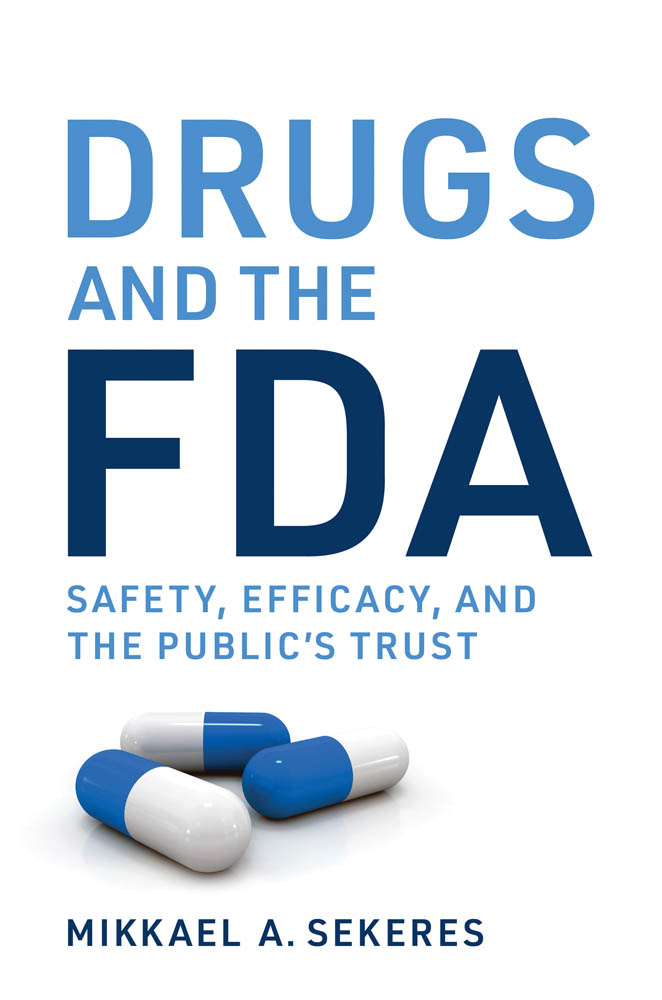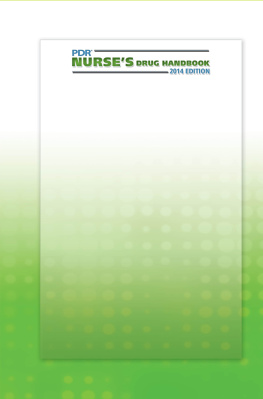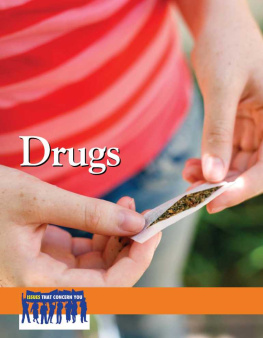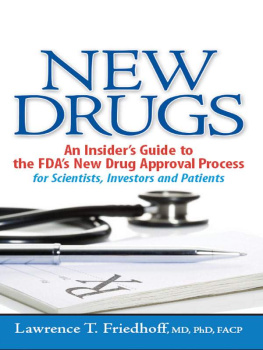Contents
List of Figures
List of Tables
Guide
Pagebreaks of the print version

Drugs and the FDA
Safety, Efficacy, and the Publics Trust
Mikkael A. Sekeres
The MIT Press
Cambridge, Massachusetts|London, England
2022 Mikkael A. Sekeres
All rights reserved. No part of this book may be reproduced in any form by any electronic or mechanical means (including photocopying, recording, or information storage and retrieval) without permission in writing from the publisher.
The MIT Press would like to thank the anonymous peer reviewers who provided comments on drafts of this book. The generous work of academic experts is essential for establishing the authority and quality of our publications. We acknowledge with gratitude the contributions of these otherwise uncredited readers.
Library of Congress Cataloging-in-Publication Data
Names: Sekeres, Mikkael A., author.
Title: Drugs and the FDA : safety, efficacy, and the publics trust / Mikkael A. Sekeres.
Description: Cambridge, Massachusetts : The MIT Press, [2022] | Includes bibliographical references and index.
Identifiers: LCCN 2021051380 | ISBN 9780262047319 (hardcover)
Subjects: MESH: United States. Food and Drug Administration. | Drug Approval | United States Government Agencies | Bevacizumabtherapeutic use | Breast Neoplasmsdrug therapy | Antibodies, Monoclonal, Humanizedtherapeutic use. | United States
Classification: LCC HV5825 | NLM QV 771 | DDC 362.290973dc23/eng/20211228
LC record available at https://lccn.loc.gov/2021051380
d_r0
To my wife, Jennifer, and children, Gabriel, Samantha, and Silas, the centers of my world; for my parents, my brother, Art and Pat Long, and my teachers, you made me who I am; and always for my patients, who teach me how to live a life, and remind me every day to cherish it
Contents
List of Figures
.
.
.
Typical setup of ODAC meetings in the Great Room at the FDA.
.
.
Four children affected by thalidomide.
.
Damage to a cells genes can cause damage to result in cancer cell growth.
Getting a drug to market can take more than a decade, from the time of discovery, to testing, and through clinical trials.
.
Angiogenesis researcher Judah Folkman, MD, conducting an experiment with chick eggs, 1974. Source: Photo from Folkman lab from Anca-Maria Cimpean, Domenico Ribatti, and Marius Raica, A Brief History of Angiogenesis Assays, International Journal of Developmental Biology 55 (2011): 377382.
.
.
.
.
An example of why reporting a median survival is not always accurate: Midostaurin. The median (approximately average) overall survival in this trial for patients with acute leukemia who received placebo (bottom line) was 25.6 months, but it was 74.7 months for those who received the drug midostaurin (top line)an exaggerated difference because the median survival occurs at the inflection point of the midostaurin survival curve. In this case, it is more representative to say that midostaurin reduced the risk of death by 22 percent. Source: R. M. Stone, S. J. Mandrekar, B. L. Sanford, et al., Midostaurin Plus Chemotherapy for Acute Myeloid Leukemia with a FLT3 Mutation, New England Journal of Medicine 377, no. 5 (August 3, 2017): 454464.
.
.
List of Tables
The Avastin Hearing Cast of Characters
Requirements for Accelerated Approval
Preface
The United States Food and Drug Administrationthe FDAis the most trusted regulatory body in the world. Because of the confidence we place in the agency, we have the luxury of ignoring (or casually tossing out) the complicated labels and package inserts it writes for our medications, or of muting the television commercials that urge us to consult a physician if we experience the following side effects. But no matter how we look at it, the FDAs responsibilityand thus its effect on our livesis enormous. That was made crystal clear through its emergency-use authorization, and eventual approval, of vaccines to combat COVID-19.
The FDA protects the public health in myriad ways: by ensuring the safety, efficacy, and security of human and veterinary drugs, biological products, and medical devices; and by ensuring the safety of our nations food supply, cosmetics, and products that emit radiation. It helps to speed innovations that make medical products more effective, safer, and more affordable, and it helps the public get the accurate, science-based information they need to use medical products and foods to maintain and improve their health.
The FDA also regulates more than $1 trillion worth of products each year. Because of the FDA, as a doctor I can comfortably prescribe medications knowing their potential risks and benefits, and as a patient and consumer I can take medications with the same confidence. Frankly, because of the FDA, my patients and I are living far longer and much better than if we had been born a century earlier.
The legislation that led to its birth, though, resulted from tragedy. And this history, along with how the FDA has evolved in response to public pressure, informs the decisions it makes about drug approvals today.
Prior to the twentieth century, drug manufacturers could hawk any potion, claim treatment of any ailment, and hail efficacy or potency on a bottles label to any extent that they wanted, all in the name of increasing sales.
After all, no agency had authority to rein them in, or to ensure that their manufacturing processes and distribution plans were consistent and safe.
But then, dozens of children were given poisoned vaccines for smallpox and diphtheria, and many died. This is particularly poignant as we have debated the safety of vaccines sanctioned under an emergency-use authorization for the treatment of that other infection, COVID-19, and whether we should trust the FDAs assessment of their safety.
Soon after, the first federal regulations of biologic products were put into place.
Then, it took the deaths of dozens of children and adults, all prescribed an antibiotic by their trusted family doctors, before the FDA was empowered to actually require that drugs be safe for ingestion or injection.
But the clout to demand whether drugs actually workto demand they be effective? That took thousands of children from around the world being born terribly disfigured, without arms, sometimes without legs or ears, and sometimes with just the ghostly suggestion of any of these appendages.
Because of its unholy birth, the FDA is cautious before it approves drugs for marketing in the United States. Embedded in its very DNA, first and foremost, is its mission to ensure a drugs safety, safety, safety. As a result, medicines given marketing approval in the United States are considered the safest in the world.
But for people with life-threatening illnesses who see their own mortality staring at them starkly at preternaturally young ageslike the patient James Petrarcha portrayed in this book, a composite of people I have cared forthe FDA can be maddeningly deliberate and slow to get medicines approved. When confronting a deadly scourge of unknown cause and undiscovered cure, be it AIDS or COVID-19particularly with a cold and uncaring government in powera community faced with just such a health crisis revolts, protesting loudly enough to be heard, to provoke change.





